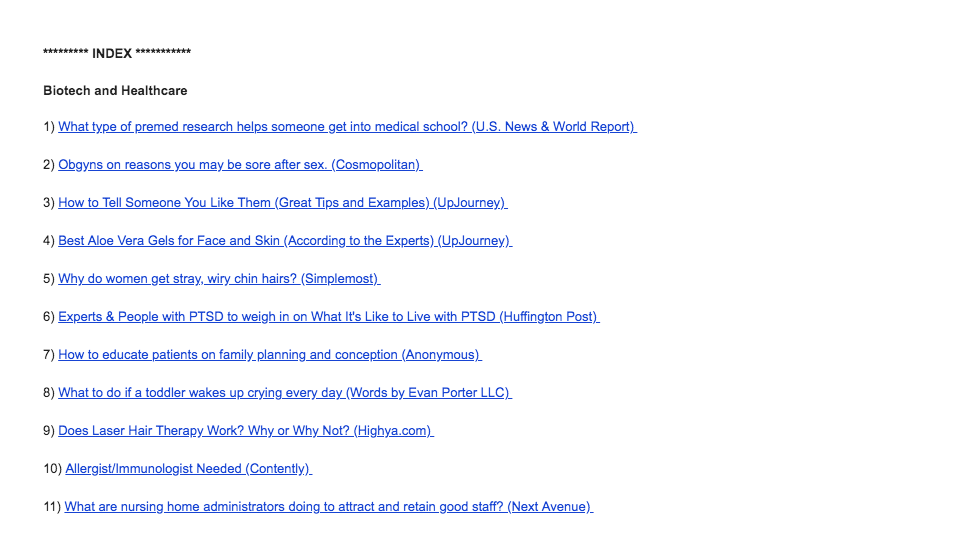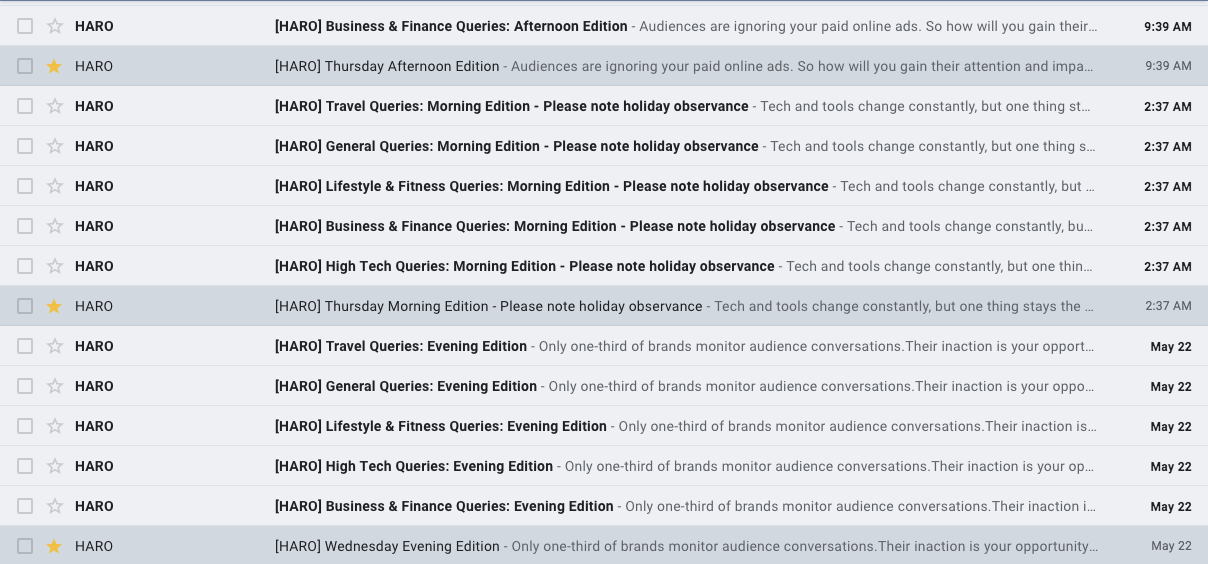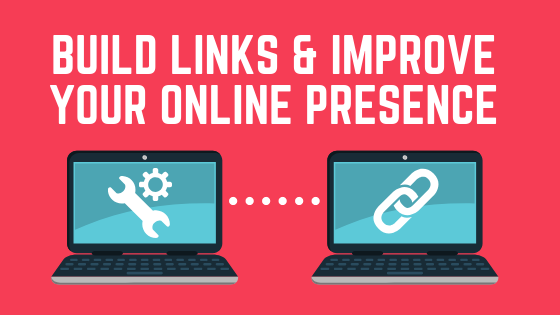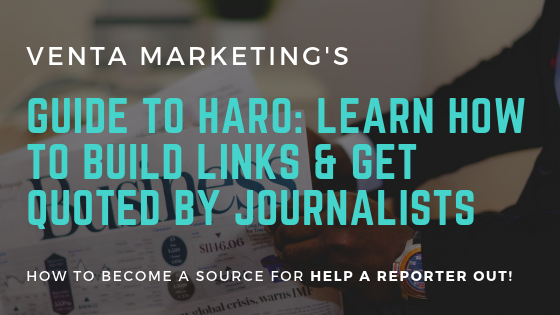What Do I Need To Know About HARO?
In 2008, PR guru Peter Shankman would regularly receive requests from the press looking for sources on everything from professional gardeners to Fortune 100 CTO’s. Peter compiled all of these expert requests and started sending a daily summary email to his massive subscriber list of PR pros and experts. And thus, Help a Reporter Out, or ‘HARO’ was born!
HARO’s list of subscribers and sources have continued to grow since Shankman sold his company to CISION – PR Newswire and they now reach over 3,000 newsrooms. With that kind of growth, you can catch the attention of journalists and prominent media outlets if you act quickly and reply with the right knowledge.
Do I Have To Pay For HARO?
HARO works on a freemium model, meaning they have their free service, as well as the ability to pay for a subscription to reap additional benefits.
Does HARO Work?
Absolutely! Submitting HARO Pitches and getting your business linked in articles is a HUGE win for your Search Engine Optimization strategy. The vast majority of businesses that use HARO do not see a dramatic, overnight boost in web traffic from just one link or citation in an article. Instead, think of using HARO on the long road to link building success. If each link is a single brick in your Great Wall of Links, then you want the strongest (most trafficked) bricks from the most prominent media outlets. These outlets will give you the high quality links that make an impact on your Domain Authority.
There Are No Guarantees
It’s important to know that just because you submit to a HARO Query, doesn’t guarantee you a quote or feature in the article. Journalists receive dozens to hundreds of replies once their query is dispersed so keep that in mind when you are crafting your Pitches. It takes time and effort to refine your pitching skills, get familiar with different journalists, and, if you’re in a very specific niche, wait for a relevant request to come through. You want your Pitch to directly and thoroughly answer their Queries while showing off your expertise and knowledge.
1. HARO Query Emails Are Sent 3 Times A Day
When you sign up for HARO, you will receive a batch of emails three times a day. HARO Query emails contain about 10-100 queries from reporters, freelancers, and media outlets from all over the world asking for your insight, interviews, and quotes.
- HARO emails are sent at 5:45 AM, 12:45 PM, and 5:45 AM (EST) every day, Monday-Friday.

As your eyes scan through the index of industry-specific emails, keep an eye out for the topics that you can reply to. When you’ve found the right queries, click on the individual queries and they will open up with the query details.
- Query details include the topic, questions, name of the reporter, deadline to submit, and the requirements of the post.
- Make sure you follow the reporter’s requirements! If you don’t then your Pitch will probably be taken out of consideration.
- You will notice that the email attached to the individual reporter is a masked address and this protects reporters from having their emails harvested and getting spammed. The masked address will alert the reporter of your reply and then they will review your Pitch.
We recommend signing up for every available category in HARO just so you know that you’re not missing out on a great linking opportunity. More on this in another couple of sections.

HARO TIP: To keep your HARO email batches organized, store them in a separate email folder, titled “HARO”, and star the “Morning, Afternoon, and Evening Editions”. These starred emails contain all of the daily HARO Queries and you can read through them and reply faster.

2. Replying To HARO Query Emails
STEP 1: Select the Query that appeals to you or aligns with your business and click on the Query to read through the description, questions, and requirements.
- Example: A Chiropractor should reply to “The Best Exercises for Lower Back Pain”
STEP 2: Open a new email and title it “HARO PITCH:” then copy and paste the name of the Query in the title bar.
- Example “HARO PITCH: The Best Exercises for Lower Back Pain”
STEP 3: Copy and paste your HARO PITCH template into the body of the email. Your template should look something like this…
“Hello [reporter name],
My name is [FIRST NAME] [LAST NAME] and would be happy to be included in your article. I am the [JOB TITLE/CLIENT BIO] at [BUSINESS NAME] and I have over [# OF YEARS IN THE INDUSTRY] + [WEBSITE NAME/LINK]. We also specialize in [HARO PITCH SPECIFIC FACT/DETAIL/EXPERIENCE].
Here are the answers to your queries, please let me know if you need any further information, case studies, or insight from me.
- [RESPONSE TO THE QUERY + INSERT RELEVANT LINKS FROM YOUR WEBSITE]
Thank you!”
Once your template is pasted into the body of the email, customize it for each individual pitch and add any links that you think would be helpful to the reporter.
HARO TIP: Keep your Pitch concise and reply as soon as possible. Reporters receive tons of replies so you want to make sure that your Pitch is promptly received, readable, filled with facts, and relevant to their article.
STEP 4: Once you have proofread your Pitch, hit SEND and wait for a reply. As we mentioned earlier, you’re not guaranteed a reply from the reporters so if you don’t hear from them – it’s okay! There will always be a new opportunity tomorrow.
For HARO to be worth your time, you’ll need to be able to check the HARO requests as soon as they get to you, and, if you find a relevant request, be able to put together a response soon after.
If your schedule isn’t very flexible, or you know you won’t be able to set aside time around the email send times, then find an employee that can monitor HARO and reply for you.

3. They Replied To My Pitch!
If you receive a reply from a reporter they most likely want to use your pitch or schedule a time to interview you about the topic of their article. From this point on you will be communicating with the reporter directly and will be able to see their full name and real email address.
It’s important to follow up with these questions when communicating with a HARO reporter:
- Will you be linking to my website in this article?
- Will you send me a link to the article once it’s live?
Subscribing To HARO
We know that you have options when it comes to subscribing to the HARO email list. But what do you gain from subscribing to a paid plan vs. their standard free plan?
Check out the HARO plans page to see and compare the benefits range of plans. Paid plan benefits include being able to more easily filter for specific keywords, making the sorting process easier, to getting earlier access to requests than the free audience. If you’re on a budget, the free plan gets the job done and you will have access to just as many Queries.
As you know, HARO Query emails deploy at the same time every day and if you have an efficient system of quickly filtering through the requests, using your template to craft authentic responses and time, you probably don’t need to look into the paid options unless you are in a very competitive niche.
SIGN UP TODAY!
Advice From Real Reporters!
“I receive dozens of irrelevant pitches per day, and quite candidly, these messages drive me nuts because I have no choice but to ignore them (and that’s a really rude thing to do). From 2012 to 2015, I was pitched more than 10,500 times. Out of this batch, there have been a few hundred pitches that have really stood out. They were relevant, on-point, unobtrusive, and truly helpful in speaking to my goals.”
“I receive countless HARO pitches with source bios that are 2-4 paragraphs long. I know your content is amazing, but when I’m scanning hundreds of pitches, it’s very easy for me to get lost in the details. Ideally, I’d love to see a one to two sentence bio, max—one that allows me to quickly scan the person’s vantage point and experience.”
“I love it when PR pros send me a sneak preview into the potential interview: a few sentences, or paragraphs, that clearly demonstrate what the person has to say. This information allows me to decide whether an in-depth interview is worth it: thoughtful, to-the-point comments yield thoughtful, to-the-point interviews.”
“I care about what the interviewee has to say and am less concerned with how many patents the person holds or how many 30 Under 30 awards that he or she has won.”
“In your HARO pitches, mention if you’ve been published in a story before. This simple action will jog your recipient’s memory and kickstart a conversation. Show that you’re paying attention. We’re listening, and good journalists appreciate the thoughtfulness.”
“HARO doesn’t have the most robust user interface for sorting and categorizing messages, so it’s easy for communication to fall through the cracks under tight deadlines. The content world is chaotic. Make a simple email signature, so writers can find your info/details that they need, in one place.”
Your HARO Pitch Checklist
Now that you know how to use HARO and have crafted your beautiful Pitch template – it’s time to get started. But wait!
The devil is in the details, and you only have one shot at capturing a journalist’s attention. Before you hit send, run through this list of questions to make sure your Pitch is pitch-perfect.
- Do you meet all of the journalist’s background and credential requirements? If not, it’s not worth your time to pitch them. Save your Pitch and wait for a request that has requirements you can meet. Otherwise, you risk the writer associating your name with the irritation they feel when they open a Pitch, read it, and realize it doesn’t meet their standards.
- Did you open with a greeting? Always be polite and don’t jump right into answering their questions without saying Hello!
- If you have the reporter’s first name, did you address them by it in said greeting? Be personal and don’t let your template prevent you from using your manners.
- Did you answer the exact question asked and follow all of the reporter’s instructions? If a word count limit is set for the response to make sure you stick to the rules.
- Is your subject line clearly tied to their Query? Writers could easily have multiple HARO requests going at the same time, so make it clear which one you’re responding to. Copy and paste exactly what they wrote in the email subject bar.
- Did you include your source’s name? If you are quoting a source be sure to include their name and a link.
- Did you include your job title?
- Did you include your website and company name?
- Did you include links to your social media profiles?
- Did you include a link to your blog post(s)?
- Did you edit for grammar and spelling?
- Are you sending your response within 12 hours of when the HARO email was sent? If not, consider saving your pitch for another time. Late submissions are never accepted because reporters move too quickly.
- Is your response as short as you can make it? Too long and you risk looking too self-involved and losing the journalist’s attention. Remember: It’s their story; you’re just a small part of it so keep it concise.
- Did you make your pitch skimmable? did you use line breaks and bullet points to break up content into chunks? Again, writers are short on time so make things easy for them to read with your spacing.
- Is your pitch 100% on topic? If you notice a tangent or wonder if a section could be seen as irrelevant, cut it down.
You’re Ready!
HARO can be a good way to supplement your link building efforts, but only if you are willing to hone your pitching skills and editing skills, and have the ability to respond in a timely manner. If you choose to experiment with HARO, make sure you track how much time you spend on your pitches so you’ll be able to look back and make sure it’s effort well-spent.
At its core, HARO is all about making a connection with someone else, and hopefully providing them something that will make their lives easier. In the spirit of helping a reporter out, don’t forget to use our checklist and make your Pitch more appealing to the journalists.


